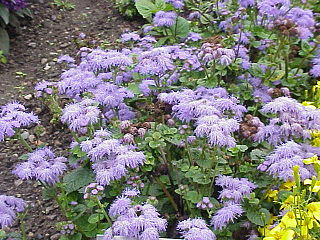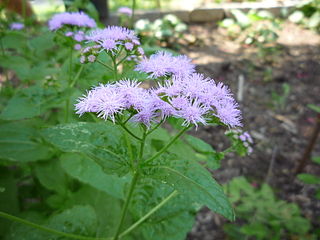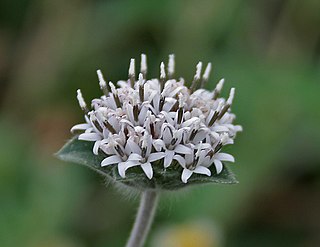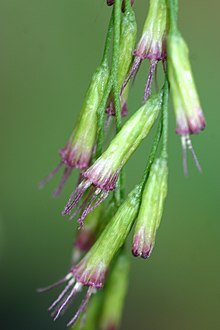Harold Ernest Robinson was an American botanist and an entomologist.

The Heliantheae are the third-largest tribe in the sunflower family (Asteraceae). With some 190 genera and nearly 2500 recognized species, only the tribes Senecioneae and Astereae are larger. The name is derived from the genus Helianthus, which is Greek for sun flower. Most genera and species are found in North America and South America, particularly in Mexico. A few genera are pantropical.

Eupatorium is a genus of flowering plants in the aster family, Asteraceae, containing from 36 to 60 species depending on the classification system. Most are herbaceous perennials growing to 0.5–3 m (1.6–9.8 ft) tall. A few are shrubs. The genus is native to temperate regions of the Northern Hemisphere. Most are commonly called bonesets, thoroughworts or snakeroots in North America. The genus is named for Mithridates Eupator, king of Pontus.

Eupatorieae is a tribe of over 2000 species of plants in the aster family. Most of the species are native to tropical, subtropical, and warm temperate areas of the Americas, but some are found elsewhere. Well-known members are Stevia rebaudiana, a number of medicinal plants (Eupatorium), and a variety of late summer to autumn blooming garden flowers, including Ageratum (flossflower), Conoclinium (mistflower), and Liatris.

Acmella is a genus of plants in the aster family, Asteraceae, described as a genus in 1807. It is native to the Americas and has been introduced to Asia, Africa, the Pacific islands, and Australia.
Idiopappus is a genus of flowering plant in the family Asteraceae. It contains the species Idiopappus quitensis and Idiopappus saloyensis.
Pappobolus is a genus of flowering plant in the sunflower family native to the Andes Mountains of Colombia, Ecuador, and Peru.

Viguiera is a genus of flowering plants in the sunflower family, Asteraceae. The name honours French physician L. G. Alexandre Viguier (1790–1867). It contains around 150 species, which are commonly known as goldeneyes and are native to the New World. These are herbs to bushy shrubs that bear yellow or orange daisy-like flowers.

Asteroideae is a subfamily of the plant family Asteraceae. It contains about 70% of the species of the family. It is made of several tribes, including Astereae, Calenduleae, Eupatorieae, Gnaphalieae, Heliantheae, Senecioneae and Tageteae. Asteroideae contains plants found all over the world, many of which are shrubby. There are about 1,135 genera and 17,200 species within this subfamily; the largest genera by number of species are Helichrysum (500-600) and Artemisia (550). Asteroideae is said to have begun approximately 46-36.5 million years ago.

The Cichorioideae are a subfamily of the family Asteraceae of flowering plants. Familiar members of Cichorioideae include lettuce, dandelions, chicory and Gazania species. The subfamily comprises about 240 genera and about 2900 species. It is heterogeneous and hard to characterize except with molecular characters.
Synantherology is a branch of botany that deals with the study of the plant family Asteraceae. The name of the field refers to the fused anthers possessed by members of the family, and recalls an old French name, synantherées, for the family.

Conoclinium, the mistflowers, is a genus of four species of herbaceous perennial flowering plants, native to North America. They are 0.5 to 2 metres tall, and have blue to purple or violet flowers.
Asanthus is a small genus of flowering plants in the daisy family, found only in northern Mexico and the southwestern United States.
Brickelliastrum is a North American genus of flowering plants in the tribe boneset tribe within the sunflower family. Brickelliastrum has at times been lumped with Brickellia or Steviopsis, but chromosome number (x=10) and molecular data are in agreement in showing that it is distinct from either of these. Despite having the general appearance of Brickellia, members of Brickelliastrum have cypselae that have only 5-7 ribs, funnel-shaped corollas, and a style with an unenlarged, glabrous base.
Dissothrix is a genus of flowering plants in the daisy family, Asteraceae.
Steviopsis is a genus of Mexican plants in the boneset tribe within the sunflower family.

Hymenostephium is a genus of flowering plants in the family Asteraceae. It includes herbs and slender shrubs that occur from Mexico through Central America and into South America.

Lagascea is a genus of flowering plants in the family Asteraceae. It occurs primarily in Mexico, but some species extend into Central America and one reaches north into the western United States. One species, L. mollis, has been widely introduced to other localities around the tropics and subtropics.

Tuber is a genus in the Tuberaceae family of fungi. It includes several species of truffles that are highly valued as delicacies.
Guy L. Nesom is an American writer and botanist.











